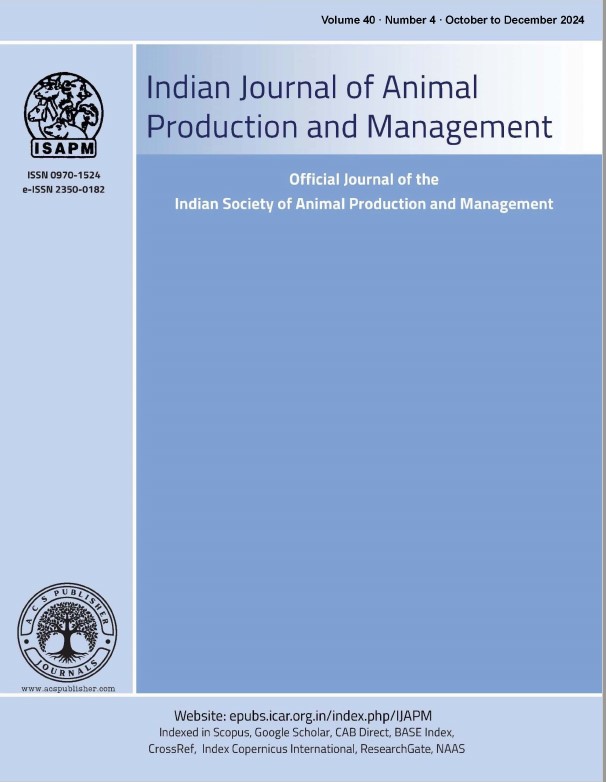Effects of Non-genetic Factors on First Dry Period in Hariana cattle atorganized farm
DOI:
https://doi.org/10.48165/ijapm.2025.41.1.06Keywords:
first dry period, genetic correlation Hariana cow, heritability, least-squares analysisAbstract
Data of 705 Hariana cows, maintained at livestock farm complex, UP Pandit Deen Dayal Upadhyaya Pashu Chikitsa Vigyan Vishwavidyalaya Evam Go Anusandhan Sansthan, DUVASU, Mathura, for a period from 1962 and 2024 was collected to study effect of non-genetic factors on first dry period. The non-genetic factor effects such as period, season and AFC age group were studied by least-squares analysis. The differences between two subclasses of each effect were tested by Duncan Multiple Range Test. Heritability was estimated by paternal half-sib correlation method. First dry period was 306.6 days, with standard error and standard deviation of 7.34 and 193.7 respectively. The overall least-squares mean for first dry period estimated were 297.54 ± 9.60 days. Season and period of calving had significant effect on first dry period. AFC had non-significant effect on first dry period. The heritability estimates for first service period was 0.164. Genetic correlation of first dry period with breeding efficiency (Wilcox method), breeding efficiency (Tomar method) and age at first calving was -0.946, -0.968 and 0.212 respectively.
References
Becker, W. A. (1975). Manual of Quantitative Genetics. 3rd Edi tion. Program in Genetics, Washington State University, Washington, USA.
Dahiya, D. S. (2002). Relative efficiency of sire evaluation proce dures for milk production incorporating auxiliary traits in Hariana cattle. Ph.D. Thesis submitted to Chaudhary Charan Singh Haryana Agricultural University, Hisar (Haryana), In dia.
Dalal, D. S., Rathi, S. S. and Raheja, K. L. (2002). Estimates of ge netic and phenotypic parameters of first lactation and lifetime performance traits in Hariana cattle. Indian Journal of Animal Sciences, 72: 398-401.
Doharey, M. (2012). Evaluation of projection of lifetime perfor mance traits in Hariana cattle. M.V.Sc Thesis submitted to Lala Lajpat Rai University of Veterinary and Animal Sciences (LUVAS), Hisar (Haryana), India.
Harvey, W. R. (1987). Least squares analysis of data with unequal subclass numbers. ARS H-4, USDA, Washington D.C.
Kaushik, R. (2000). Genetic studies on reproduction, production and reproductive health of Hariana cattle. M.V.Sc. Thesis, Chaudhary Charan Singh Haryana Agricultural University, Hisar (Haryana), India.
Kramer, C. Y. (1957). Extension of multiple range tests to group correlated adjust means. Biometrics, 13: 13-18.
Kumar, S. (2006). Genetic studies on performance traits of Hari ana cattle under progeny testing. M.V.Sc Thesis submitted to Chaudhary Charan Singh Haryana Agricultural University, Hisar, (Haryana), India.
Kumar, N. (2009). Age adjustment factors for milk production in Hariana cattle. M.V.Sc Thesis submitted to Chaudhary Cha ran Singh Haryana Agricultural University, Hisar (Haryana), India.
Kumar, D., Verma, S. B., Singh, S. R., Mandal, K. G. and Pandey, R. P. (2005). Effect of genetic and non-genetic factors on dry pe riod and age at first calving in Hariana and its crosses. Indian Journal of Animal Health, 44: 99-102.
Olesen, I., Groen, A. F. and Gjerde, B. (2000). Definition of animal breeding goals for sustainable production systems. Journal of Animal Science 78, 570–582.
Pal, A. (2009). Genetic evaluation of sires of Hariana cattle. M.V.Sc Thesis submitted to Chaudhary Charan Singh Haryana Agri cultural University, Hisar (Haryana), India.
Pandey, S.K., Arora, V.K., Goel, R. and Singh, R. (2001). Genetic and phenotypic studies of some production traits of Hariana cattle. Indian Journal of Animal Research, 35: 129-131.
PDC Annual Report. 1991-92. Project Directorate on cattle, Meerut (Uttar Pradesh), India.
Shetkar, M., Kumar, V., Singh, S. P., Singh, Y., Kumar, M. and Singh, K. (2021). Genetic analysis of first dry period and lifetime per formance in Hariana cattle. Indian Journal of Animal Sciences 91 (12): 1103–1105.
Singh, R. (2001). Genetic studies in closed population on Hariana cattle. M.V.Sc Thesis submitted to Chaudhary Charan Singh Haryana Agricultural University, Hisar (Haryana), India.
Singh, S. (2002). Genetic studies on lifetime performance traits in Hariana cattle. PhD Thesis submitted to Chaudhary Charan Singh Haryana Agricultural University, Hisar (Haryana), In dia.
Snedecor, G. W. and Cochran, W. G. (1994). Statistical methods (eighth edition). Calcutta, India: Oxford and IBH Publishing. Swami, P. D., Kumar, V, Murdia, C. K., Barhat, N. K., Joshi, R. K. and Kumar, P. (2005). Effect of non-genetic factors on produc tion traits in Hariana cattle. Indian Journal of Dairy Science, 58: 299-301.
Tomar, K., Kumar, R., Tyagi, K. K., Gupta, A., Yadav, S. P., Sahu, D. S., Singh, D., Dubey, K. K. and Singh, K. (2022). Performance evaluation of first lactation and lifetime production and repro duction traits of Hariana cattle. The Pharma Innovation Jour nal, 11: 2586-2590.

